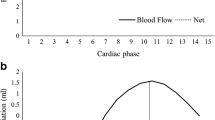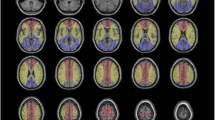Abstract
Introduction
The objectives of this paper are to assess collateral blood flow in posterior circulation occlusion by MRI-based approaches (fluid-attenuated inversion recovery (FLAIR) vascular hyperintensities (FVHs), collateralization on dynamic 4D angiograms) and investigate its relation to ischemic lesion size and growth.
Methods
In 28 patients with posterior cerebral artery (PCA) and 10 patients with basilar artery (BA) occlusion, MRI findings were analyzed, with emphasis on distal FVH and collateralization on dynamic 4D angiograms.
Results
In PCA occlusion, distal FVH was observed in 18/29 (62.1 %), in BA occlusion, in 8/10 (80 %) cases. Collateralization on dynamic 4D angiograms was graded 1 in 8 (27.6 %) patients, 2 in 1 (3.4 %) patient, 3 in 12 (41.4 %) patients, and 4 in 8 (27.6 %) patients with PCA occlusion and 0 in 1 (10 %) patient, 2 in 3 (30 %) patients, 3 in 1 (10 %) patient, and 4 in 5 (50 %) patients with BA occlusion. FVH grade showed neither correlation with initial or follow-up diffusion-weighted image (DWI) lesion size nor DWI–perfusion-weighted imaging (PWI) mismatch ratio. Collateralization on dynamic 4D angiograms correlated inversely with initial DWI lesion size and moderately with the DWI–(PWI) mismatch ratio. The combination of distal FVH and collateralization grade on dynamic 4D angiograms correlated inversely with initial as well as follow-up DWI lesion size and highly with the DWI–PWI mismatch ratio.
Conclusions
In posterior circulation occlusion, FVH is a frequent finding, but its prognostic value is limited. Dynamic 4D angiograms are advantageous to examine and graduate collateral blood flow. The combination of both parameters results in an improved characterization of collateral blood flow and might have prognostic relevance.



Similar content being viewed by others
References
Bogousslavsky J, Van Melle G, Regli F (1988) The Lausanne stroke registry: analysis of 1,000 consecutive patients with first stroke. Stroke 19:1083–1092
Bamford J, Sandercock P, Dennis M, Burn J, Warlow C (1991) Classification and natural history of clinically identifiable subtypes of cerebral infarction. Lancet 337:1521–1526
Caplan L, Chung CS, Wityk R, Glass T, Tapia J, Pazdera L, Chang HM, Dashe J, Chaves C, Vemmos K, Leary M, Dewitt L, Pessin M (2005) New England medical center posterior circulation stroke registry: I. Methods, data base, distribution of brain lesions, stroke mechanisms, and outcomes. J Clin Neurol 1:14–30
Förster A, Griebe M, Gass A, Hennerici MG, Szabo K (2011) Recent advances in magnetic resonance imaging in posterior circulation stroke: implications for diagnosis and prognosis. Curr Treat Options Cardiovasc Med 13:268–277
Förster A, Gass A, Kern R, Wolf ME, Hennerici MG, Szabo K (2011) MR imaging-guided intravenous thrombolysis in posterior cerebral artery stroke. AJNR Am J Neuroradiol 32:419–421
Miteff F, Levi CR, Bateman GA, Spratt N, McElduff P, Parsons MW (2009) The independent predictive utility of computed tomography angiographic collateral status in acute ischaemic stroke. Brain 132:2231–2238
Menon BK, O'Brien B, Bivard A, Spratt NJ, Demchuk AM, Miteff F, Lu X, Levi C, Parsons MW (2013) Assessment of leptomeningeal collaterals using dynamic CT angiography in patients with acute ischemic stroke. J Cereb Blood Flow Metab 33:365–371
Azizyan A, Sanossian N, Mogensen MA, Liebeskind DS (2011) Fluid-attenuated inversion recovery vascular hyperintensities: an important imaging marker for cerebrovascular disease. AJNR Am J Neuroradiol 32:1771–1775
Hermier M, Nighoghossian N, Derex L, Wiart M, Nemoz C, Berthezene Y, Froment JC (2005) Hypointense leptomeningeal vessels at T2*-weighted MRI in acute ischemic stroke. Neurology 65:652–653
Hermier M, Ibrahim AS, Wiart M, Adeleine P, Cotton F, Dardel P, Derex L, Berthezene Y, Nighoghossian N, Froment JC (2003) The delayed perfusion sign at MRI. J Neuroradiol 30:172–179
Campbell BC, Christensen S, Tress BM, Churilov L, Desmond PM, Parsons MW, Barber PA, Levi CR, Bladin C, Donnan GA, Davis SM (2013) Failure of collateral blood flow is associated with infarct growth in ischemic stroke. J Cereb Blood Flow Metab 33:1168–1172
Chalela JA, Alsop DC, Gonzalez-Atavales JB, Maldjian JA, Kasner SE, Detre JA (2000) Magnetic resonance perfusion imaging in acute ischemic stroke using continuous arterial spin labeling. Stroke 31:680–687
Chng SM, Petersen ET, Zimine I, Sitoh YY, Lim CC, Golay X (2008) Territorial arterial spin labeling in the assessment of collateral circulation: comparison with digital subtraction angiography. Stroke 39:3248–3254
Wu B, Wang X, Guo J, Xie S, Wong EC, Zhang J, Jiang X, Fang J (2008) Collateral circulation imaging: MR perfusion territory arterial spin-labeling at 3T. AJNR Am J Neuroradiol 29:1855–1860
Cosnard G, Duprez T, Grandin C, Smith AM, Munier T, Peeters A (1999) Fast FLAIR sequence for detecting major vascular abnormalities during the hyperacute phase of stroke: a comparison with MR angiography. Neuroradiology 41:342–346
Iancu-Gontard D, Oppenheim C, Touze E, Meary E, Zuber M, Mas JL, Fredy D, Meder JF (2003) Evaluation of hyperintense vessels on FLAIR MRI for the diagnosis of multiple intracerebral arterial stenoses. Stroke 34:1886–1891
Yoshioka K, Ishibashi S, Shiraishi A, Yokota T, Mizusawa H (2012) Distal hyperintense vessels on FLAIR images predict large-artery stenosis in patients with transient ischemic attack. Neuroradiology 55(2):165–169
Wolf RL (2001) Intraarterial signal on fluid-attenuated inversion recovery images: a measure of hemodynamic stress? AJNR Am J Neuroradiol 22:1015–1016
Sanossian N, Saver JL, Alger JR, Kim D, Duckwiler GR, Jahan R, Vinuela F, Ovbiagele B, Liebeskind DS (2009) Angiography reveals that fluid-attenuated inversion recovery vascular hyperintensities are due to slow flow, not thrombus. AJNR Am J Neuroradiol 30:564–568
Lee KY, Latour LL, Luby M, Hsia AW, Merino JG, Warach S (2009) Distal hyperintense vessels on FLAIR: an MRI marker for collateral circulation in acute stroke? Neurology 72:1134–1139
Haussen DC, Koch S, Saraf-Lavi E, Shang T, Dharmadhikari S, Yavagal DR (2013) FLAIR distal hyperintense vessels as a marker of perfusion-diffusion mismatch in acute stroke. J Neuroimaging 23:397–400
Maeda M, Yamamoto T, Daimon S, Sakuma H, Takeda K (2001) Arterial hyperintensity on fast fluid-attenuated inversion recovery images: a subtle finding for hyperacute stroke undetected by diffusion-weighted MR imaging. AJNR Am J Neuroradiol 22:632–636
Toyoda K, Ida M, Fukuda K (2001) Fluid-attenuated inversion recovery intraarterial signal: an early sign of hyperacute cerebral ischemia. AJNR Am J Neuroradiol 22:1021–1029
Seo KD, Lee KO, Choi YC, Kim WJ, Lee KY (2013) Fluid-attenuated inversion recovery hyperintense vessels in posterior cerebral artery infarction. Cerebrovasc Dis Extra 3:46–54
Wu J, Tarabishy B, Hu J, Miao Y, Cai Z, Xuan Y, Behen M, Li M, Ye Y, Shoskey R, Haacke EM, Juhasz C (2011) Cortical calcification in Sturge-Weber syndrome on MRI-SWI: relation to brain perfusion status and seizure severity. J Magn Reson Imaging 34:791–798
Tatu L, Moulin T, Bogousslavsky J, Duvernoy H (1996) Arterial territories of human brain: brainstem and cerebellum. Neurology 47:1125–1135
Tatu L, Moulin T, Bogousslavsky J, Duvernoy H (1998) Arterial territories of the human brain: cerebral hemispheres. Neurology 50:1699–1708
Rosset A, Spadola L, Ratib O (2004) OsiriX: an open-source software for navigating in multidimensional DICOM images. J Digit Imaging 17:205–216
Tsushima Y, Endo K (2001) Significance of hyperintense vessels on FLAIR MRI in acute stroke. Neurology 56:1248–1249
Gawlitza M, Gragert J, Quaschling U, Hoffmann KT (2014) FLAIR-hyperintense vessel sign, diffusion-perfusion mismatch and infarct growth in acute ischemic stroke without vascular recanalisation therapy. J Neuroradiol
Higashida RT, Furlan AJ, Roberts H, Tomsick T, Connors B, Barr J, Dillon W, Warach S, Broderick J, Tilley B, Sacks D (2003) Trial design and reporting standards for intra-arterial cerebral thrombolysis for acute ischemic stroke. Stroke 34:e109–e137
Cross DT III, Moran CJ, Akins PT, Angtuaco EE, Derdeyn CP, Diringer MN (1998) Collateral circulation and outcome after basilar artery thrombolysis. AJNR Am J Neuroradiol 19:1557–1563
Brozici M, van der ZA, Hillen B (2003) Anatomy and functionality of leptomeningeal anastomoses: a review. Stroke 34:2750–2762
Weidner W, Crandall P, Hanafee W, Tomiyasu U (1965) Collateral circulation in the posterior fossa via leptomeningeal anastomoses. Am J Roentgenol Radium Ther Nucl Med 95:831–836
Kamran S, Bates V, Bakshi R, Wright P, Kinkel W, Miletich R (2000) Significance of hyperintense vessels on FLAIR MRI in acute stroke. Neurology 55:265–269
Cheng B, Ebinger M, Kufner A, Kohrmann M, Wu O, Kang DW, Liebeskind D, Tourdias T, Singer OC, Christensen S, Warach S, Luby M, Fiebach JB, Fiehler J, Gerloff C, Thomalla G (2012) Hyperintense vessels on acute stroke fluid-attenuated inversion recovery imaging: associations with clinical and other MRI findings. Stroke 43:2957–2961
Schellinger PD, Chalela JA, Kang DW, Latour LL, Warach S (2005) Diagnostic and prognostic value of early MR Imaging vessel signs in hyperacute stroke patients imaged <3 hours and treated with recombinant tissue plasminogen activator. AJNR Am J Neuroradiol 26:618–624
Huang X, Liu W, Zhu W, Ni G, Sun W, Ma M, Zhou Z, Wang Q, Xu G, Liu X (2012) Distal hyperintense vessels on FLAIR: a prognostic indicator of acute ischemic stroke. Eur Neurol 68:214–220
Hohenhaus M, Schmidt WU, Brunecker P, Xu C, Hotter B, Rozanski M, Fiebach JB, Jungehulsing GJ (2012) FLAIR vascular hyperintensities in acute ICA and MCA infarction: a marker for mismatch and stroke severity? Cerebrovasc Dis 34:63–69
Ebinger M, Kufner A, Galinovic I, Brunecker P, Malzahn U, Nolte CH, Endres M, Fiebach JB (2012) Fluid-attenuated inversion recovery images and stroke outcome after thrombolysis. Stroke 43:539–542
Shuaib A, Butcher K, Mohammad AA, Saqqur M, Liebeskind DS (2011) Collateral blood vessels in acute ischaemic stroke: a potential therapeutic target. Lancet Neurol 10:909–921
Ethical standards and patient consent
We declare that all human and animal studies have been approved by the Medizinische Ethikkommission II der Medizinischen Fakultät Mannheim and have therefore been performed in accordance with the ethical standards laid down in the 1964 Declaration of Helsinki and its later amendments. Patient consent was waived for this retrospective study; however, MRI studies were performed with informed consent of the patient or the patient’s relatives.
Conflict of interest
We declare that we have no conflict of interest.
Author information
Authors and Affiliations
Corresponding author
Rights and permissions
About this article
Cite this article
Förster, A., Wenz, H., Kerl, H.U. et al. FLAIR vascular hyperintensities and dynamic 4D angiograms for the estimation of collateral blood flow in posterior circulation occlusion. Neuroradiology 56, 697–707 (2014). https://doi.org/10.1007/s00234-014-1382-7
Received:
Accepted:
Published:
Issue Date:
DOI: https://doi.org/10.1007/s00234-014-1382-7




